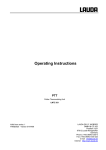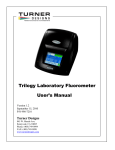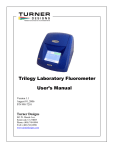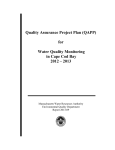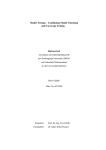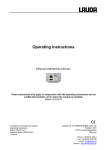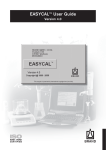Download Operating Instructions
Transcript
iVisc Operating Instructions iVisc Capillary Viscometer LMV 830 Valid from series: 1 YAME0023/04/09 LAUDA DR. R. WOBSER GMBH & CO. KG Postfach 1251 97912 Lauda-Königshofen Germany Phone: (+49) 09343/ 503-0 Fax: (+49) 09343/ 503-222 e-mail [email protected] Internet http://www.lauda.de iVisc 2 iVisc First some safety information Before you operate the device, read all the instructions and safety information thoroughly. If you have any questions or concerns, please feel free to call us. Follow the instructions about installation, operation, etc., as only then can improper handling of the device be eliminated and the full warranty coverage maintained. The device is supplied with voltage from a computer through a USB cable. Transport the device with care. The device and its internal parts can be damaged by: dropping, vibration. The device may only be operated by appropriately instructed personnel. Do not put the device into operation when damaged. Only use the device for its intended purpose. Do not make technical modifications to the device. Have service and repair work carried out only by specialists. The operating instructions contain additional safety information which is identified with a triangle with an excla. Read and follow the instructions! Ignoring the instructions can lead to severe consequences, mation mark e.g. damage to the device or other property, or to personal injury. Technical modifications reserved. Special symbols: YAME0023 / 08.12.09 Caution This sign is used when improper handling can lead to property damage and/or personal injury. Note Here, something in particular needs the reader's attention. In certain circumstances this includes a note about a hazard. Reference Refers to further information in other chapters. First some safety information 3 iVisc 4 YAME0023 / 08.12.09 iVisc Table of contents 1 Safety information............................................................................................................6 1.1 General safety information .................................................................................................6 2 Package contents.............................................................................................................7 3 Device description ...........................................................................................................8 4 Putting the device into operation ...................................................................................9 4.1 Installing the software ........................................................................................................9 4.2 Connecting the device......................................................................................................11 4.3 Installing the device..........................................................................................................11 4.4 User interface...................................................................................................................12 4.4.1 Managing capillaries.........................................................................................................14 4.4.1.1 Applying / changing capillaries...................................................................................15 4.4.1.2 Deleting capillaries .....................................................................................................16 4.4.2 Managing parameters.......................................................................................................16 5 Measurement ..................................................................................................................17 5.1 5.2 5.2.1 5.3 5.3.1 6 Appendix.........................................................................................................................21 6.1 6.1.1 6.1.2 6.1.3 6.2 6.3 6.4 6.5 7 Preparing for a measurement ..........................................................................................17 Starting the measurement................................................................................................18 Relative viscosity ..............................................................................................................19 Displaying saved measurement results ...........................................................................20 Printing out the result protocol..........................................................................................20 Formulas used .................................................................................................................21 Computation of absolute viscosity values.........................................................................21 Formulas used for solution viscosity values .....................................................................21 Approximation formulas for estimating the intrinsic viscosity ...........................................22 Update..............................................................................................................................23 Technical data..................................................................................................................23 Accessories......................................................................................................................24 Repair and service information ........................................................................................25 Index................................................................................................................................26 YAME0023 / 08.12.09 Table of contents 5 iVisc 1 Safety information 1.1 General safety information Viscosity measurements normally require very constant sample temperatures which are stabilised by means of laboratory thermostats. Hazards arise from this due to very high or very low measuring temperatures, due to fire and the general hazards arising from the application of electrical energy. The user is extensively protected by the application of the relevant standards. Further hazard sources can arise from the type of material for which the temperature is to be stabilised or from the sample to be measured, e.g. upon exceeding certain temperature thresholds or with the fracture of the capillary and reaction with the tempering liquid. In some cases hazardous liquids are used as solvents and cleaning agents when measuring viscosity with the iVisc. Here, it is essential to follow the instructions given in the safety data sheet for the hazardous substances. In particular, when filling and emptying the viscometer and the reservoir and waste containers, suitable protective gloves and goggles must be worn. Before putting the device into operation, all tubing connections must be tightened to ensure there is no leakage. Before any servicing operation or conversion all hazardous liquid residues must removed as completely as possible. The device may only be used as intended, that is as described in these operating instructions. This includes operation exclusively by instructed specialist personnel. It is not feasible to include all possible situations. They remain essentially subject to the judgement and responsibility of the user or operator. 6 Safety information YAME0023 / 08.12.09 iVisc 2 Package contents After unpacking, first check the unit and accessories for complete scope of delivery and any transport damage that may have been incurred. If the device is found to be damaged, the shipping agent must be immediately informed so that verification and appropriate measures may take place. During this process, please inform the LAUDA Service Centre ( 6.4) or an authorised LAUDA representative. Damaged devices must not be put into operation. Please check the package contents for complete scope of delivery: USB 2.0 connecting lead Allen key, 3 mm AF iVisc Capillary Viscometer CD-ROM YAME0023 / 08.12.09 Package contents Operating Instructions 7 iVisc 3 Device description 1 2 3 4 5 6 7 8 9 10 11 12 13 14 15 1. Measuring head 9. USB 2.0 connection 2. Connection of capillary to filling tube 10. Measuring head aeration 3. Connection of capillary to aeration tube 11. Upper light barrier set 4. Fault indicator 12. Viscometer capillary mounting 5. Measurement indicator 13. Lower light barrier set 6. Start / stop button 14. Adjusting screw for capillary tube connection 7. Clamping slide 15. Device base 8. Capillary tube connection 8 Device description YAME0023 / 08.12.09 iVisc 4 Putting the device into operation 4.1 Installing the software The iVisc only functions in conjunction with the software "LAUDA iVisc", which must be installed on a PC/ notebook/ netbook with the operating system Windows XP, Windows Vista or Windows 7. Before putting the device into operation for the first time, the appropriate software must be installed. For the initial installation the program starts automatically when the supplied CD-ROM is inserted. The program is selfexplanatory. A maximum of two iViscs may be operated in parallel on one PC. The operating program is always assigned to one iVisc. If you want to operate two iViscs in parallel, you must install the software twice. When the serial number is entered, it is assigned to the corresponding device. A maximum of two iViscs can be operated in parallel on one PC. It is essential to only connect the iVisc to the PC once the software has been installed. 1. Language selection for the installation. 2. Starting the installation program 3. Registration 4. Serial number of your iVisc (at rear of device) YAME0023 / 08.12.09 Putting the device into operation 9 iVisc 5. Select the destination folder for the software. 6. Backup copies for later rollback. 7. Select the Program-Manager Group. 8. Install the software. 9. Finish software installation. 10. iVisc 1.01 icon in your destination folder 10 Putting the device into operation YAME0023 / 08.12.09 iVisc 4.2 Connecting the device Once the installation is complete the iVisc may be put into operation. Place the iVisc in a stable position in a thermostatic bath and connect it to the PC using the supplied USB 2.0 cable. The USB 2.0 interface is located at the back of the device. 4.3 Installing the device Once the iVisc has been connected to the PC, the Device Manager starts automatically. 1. 2. 3. YAME0023 / 08.12.09 Putting the device into operation 11 iVisc 4.4 User interface 1 2 3 4 5 6 7 8 13 9 14 15 10 16 11 17 12 18 19 20 1. Status line stating the serial number of the corresponding iVisc. 2. Measurement status details. 3. Duration of the test. green: certified iVisc found 4. iVisc display red: no certified iVisc found 5. Start / stop button. 6. Screen enlargement / reduction for parallel operation of two systems with or 7. Capillaries tab ( 3.4.1). 8. Parameters tab ( 3.4.2). 9. Display of capillaries used ( 4.4.1). 10. Test temperature. 11. Display of measured flow times ( 5.3). 12. Display of set capillary parameters. 12 Putting the device into operation YAME0023 / 08.12.09 iVisc 13. Symbol for measurement status 14. Designation for unambiguous sample assignment 15. Measurement modes Filling Measuring Drain / Pause Sample Sample number Operator Kinematic Dynamic Relative Viscosity Viscosity Viscosity ident. 16. Selected capillary Capillary number and capillary constant 17. Other input fields Relative Concentration [g/cm³] Viscosity Solution viscosity [mm²/s] Kinematic Mean of flow time [s] Viscosity Standard deviation [s] Kin. energy correction [s] Kinematic viscosity [mm²/s] Dynamic Mean of flow time [s] Viscosity Standard deviation [s] Kin. energy correction [s] Kinematic viscosity [mm²/s] Dynamic viscosity [mPas] Relative Mean of flow time [s] Viscosity Standard deviation [s] Kin. energy correction [s] 18. Measurements Relative viscosity 19. Further selection menu Reduced viscosity [cm³/g] Inherent viscosity [cm³/g] Relative Viscosity 20. Display of test results. YAME0023 / 08.12.09 Putting the device into operation 13 iVisc 4.4.1 Managing capillaries Capillaries are managed in the capillary list. Upon starting for the first time no capillaries are applied. The window is blank. It is possible to apply new capillaries at any time, to select them and to modify and delete the parameters. 1 2 3 4 1. Capillary number. 2. Capillary size. 3. Capillary constant 4. Device No. or field for remarks. 5. The over-pump time assigned to the capillary [s] 6. The pause time assigned to the capillary [s] 7. The pump pressure assigned to the capillary 5 6 7 14 Putting the device into operation YAME0023 / 08.12.09 iVisc 4.4.1.1 Applying / changing capillaries The window appears by clicking with the right mouse key in the field Capillary list. Clicking on opens the window "Capillary input". Here, the appropriate capillary size can be selected and suitable values entered. The parameters are set using the slide controls. Confirm with lary list. and the applied capillary appears in the capil- The capillary constant specified by the manufacturer must be entered. If entry is incorrect, an error message is displayed. With a double click on an already applied capillary the window "Capillary input" appears and the parameters and capillary can be adapted. The capillary number is however retained. YAME0023 / 08.12.09 Putting the device into operation 15 iVisc 4.4.1.2 Deleting capillaries Mark the capillary to be deleted in the capillary list and appears on clicking with the right mouse key. Click on Confirming with aborts the action. 4.4.2 and a warning message appears. deletes the capillary and Managing parameters Access to the appropriate menu is obtained by clicking the tab Parameter. Here, all the necessary parameters can be set. Changing the input and output units by clicking the pull-down menus. 16 Putting the device into operation YAME0023 / 08.12.09 iVisc 5 Measurement 5.1 Preparing for a measurement Insert the selected and filled capillary into the iVisc. The capillary can be used both with a stand or without a stand. Use Adapter HKB 532 for viscometer types 3 and 4 (Micro-Ubbelohde). Connect capillary and connect the iVisc to the PC (USB 2.0). The aeration tubing must be connected to prevent the risk of chemical burns when using hazardous substances The aeration connection remains free when using Cannon-Fenske or Micro-Ubbelohde. YAME0023 / 08.12.09 Measurement 17 iVisc 5.2 Starting the measurement 1. Start the "LAUDA iVisc" program 2. Enter sample details and select measurement method 3. Add the capillary by drag & drop Start the measurement Click on or press the start button. The measurement runs automatically and the results are displayed immediately. The measurement can be interrupted at any time by clicking on or pressing the start button. Symbols, description and seconds display indicate the status of the measurement. Filling Measuring Drain / Pause Display of flow times and results. 18 Measurement YAME0023 / 08.12.09 iVisc 5.2.1 Relative viscosity For the measurement of relative viscosity there is the possibility of using the test result of an existing measurement as a reference value in that it is simply transferred by drag & drop from the results table into the field "Solvent viscosity". However, this procedure is only possible if the desired reference value is the result of a measurement of the kinematic viscosity. YAME0023 / 08.12.09 Measurement 19 iVisc 5.3 Displaying saved measurement results Results are permanently saved and displayed in the results table. A detailed display is obtained by double clicking on the relevant results row. Clicking on resets the user interface to the starting status. 5.3.1 Printing out the result protocol Click result protocol. 20 to print out a Measurement YAME0023 / 08.12.09 iVisc 6 Appendix 6.1 Formulas used The computational formulas implemented in the iVisc software are given in the following. First the quantities and correction used for the absolute viscosity values ( 6.1.1), then the computations implemented for the solution viscosity values ( 6.1.2) and the current approximation formulas for estimating the intrinsic viscosity values for plastics and other macro-molecules ( 6.1.2). 6.1.1 Computation of absolute viscosity values Method Formula Kinematic viscosity: v k (t t ) Kinetic energy correction according to Hagenbach E t k t2 Dynamic viscosity v 6.1.2 Terms Unit v k t t Kinematic viscosity Capillary constant Flow time Kinetic energy correction time mm2/s mm2/s2 s s E Kinetic energy correction factor s mm2 Dynamic viscosity Density g/cm3 Terms Unit Formulas used for solution viscosity values Method Formula Relative viscosity: v vrel solution vsolvent Specific viscosity: vspec vrel 1 K-value accord. to Fickentscher e.g. for polyvinyl chloride (PVC), polyvinyl acetate (PVA) YAME0023 / 08.12.09 vspe Specific viscosity --- c vred Reduced viscosity cm3/g vred vinh log vrel C vinh Inherent viscosity C Concentration cm3/g g/cm3 Inherent viscosity (log. viscosity number) --- v 1 rel C Reduced viscosity: (Viscosity number, VZ) vrel Relative viscosity 2 a 1 1 2 a a C K 150 300C where : a 1.5 log vrel Appendix K C K-value Concentration --g/cm3 21 iVisc 6.1.3 Approximation formulas for estimating the intrinsic viscosity Listed below are the available approximation formulas for estimating the intrinsic viscosity values for plastics and other macro-molecules by using the above solution viscosity coefficients for a specified polymer concentration and polymer-specific adaptation parameters. In contrast to the LAUDA PVS system, with the iVisc it is not possible to automatically accept a dilution series for the determination of the intrinsic viscosity according to the extrapolation method nor is it possible to graphically display it. Method Formula Solomon-Ciuta e.g. for: PMMA and others Schulz-Blaschke e.g. for:PE (polyethylene), PP (polypropylene) and others C vint vred 1 K SB C vred vint 3 ln vrel 1 vred 4 4C Billmeyer e.g. for: PETP , PBTP (polyethylene(butylene) terephthalate) and others 2 vred C ln vrel vint Huggins e.g. for: PS (polystyrene) and others Martin e.g. for: cellulose, -acetate and others Maron For special polymers 22 vint 1 4 K H vspec 1 Unit vint Intrinsic viscosity vred Reduced viscosity C Concentration cm3/g cm3/g g/cm3 KSB Schulz-Blaschke constant (e.g.: K1 = 0.27 for PE) --- (No other parameters required) --- Huggins constant --- KH 2C KH log v red log vint K MT vint C vint Terms vspec K MR log vrel KMT Martin constant (e.g.: KMT =0.13 for CED) KM Maron constant --- --- R (1 K MR ) C Appendix YAME0023 / 08.12.09 iVisc 6.2 Update It is possible to install a current firmware update for your iVisc via the LAUDA home page. 6.3 When updating the software, only one iVisc must be connected to the computer! Technical data iVisc Capillary Viscometer Meniscus detection Optical (near infra-red) Light barrier control µP Sample temperature range °C -20 to 150 Ambient temperature °C 10 to 45 Time measuring range s up to 9999.99 Recommended measuring range for flow time s 30…1000 Viscosity range mm²/s 0.3 to 30000 Time measurement resolution s 0.01 Time measurement error ppm 1 Overall power consumption W 1 Dimensions (WxDxH) mm 95x96x425 Voltage supply Weight, net YAME0023 / 08.12.09 USB kg Appendix 1.4 23 iVisc 6.4 Accessories Description Application / function LAUDA order no. Stand Secure mounting of capillary UG 003 Adapter Mounting for Micro-Ubbelohde HKB 532 Connection cap, small Aeration connection HKA 147 Connection cap, large Pressure connection HKA 148 Viton tubing 3×1.5 Tubing (available by the meter) RKJ 021 USB 2.0 AB cable Power supply for iVisc EKS 083 Centring piece Overflow connection HX 630 PC; notebook; netbook Control of the iVisc 24 Appendix Upon request YAME0023 / 08.12.09 iVisc 6.5 Repair and service information Have repairs carried out only by specialists. When sending in a device, please ensure that it is carefully and properly packed. LAUDA cannot be held liable for any damage due to improper packing. If you want to send in a device for repair, it is essential to first consult the LAUDA Instrument Service or an authorised representative. Your contact for maintenance and expert service support: LAUDA Instrument Service SMG Phone: +49 (0)9343/ 503-148 Mr. Stastny (Techn. Support) +49 (0)9343/ 503-128 Ms. Brömel (Support) We are available at any time for questions, concerns, ideas and feedback. LAUDA DR. R. WOBSER GMBH & CO. KG Postfach 1251 97912 Lauda-Königshofen Germany Phone: +49 (0)9343/ 503-0 Fax: +49 (0)9343/ 503-222 e-mail: [email protected] Internet: http://www.lauda.de YAME0023 / 08.12.09 Appendix 25 iVisc 7 Index Accessories .................................................. 24 Over-pump time. ........................................... 14 Ambient temperature .................................... 23 Package contents ........................................... 7 Capillaries Parameters ................................................... 16 applying / changing ....................................................15 Pause time.................................................... 14 deleting ......................................................................16 Power consumption ...................................... 23 managing ...................................................................14 Capillary connecting .................................................................17 Pump pressure ............................................. 14 Putting the device into operation .................... 9 Capillary constant ................................... 14, 15 Repair information ........................................ 25 Computational formulas................................ 21 Result protocol.............................................. 20 absolute viscosity.......................................................21 Safety information........................................... 3 intrinsic viscosity ........................................................22 general ........................................................................ 6 solvent viscosity .........................................................21 Sample temperature range ........................... 23 Connection ................................................... 11 Service.......................................................... 25 Device description .......................................... 8 Software Dimensions................................................... 23 installation ................................................................... 9 Hazard sources .............................................. 6 update ....................................................................... 23 Hazards .......................................................... 6 Symbols .......................................................... 3 Installation Technical data .............................................. 23 device ........................................................................11 Transport damage .......................................... 7 software ...................................................................... 9 User interface ............................................... 12 Measurement preparation.................................................................17 starting .......................................................................18 Viscosity range ............................................. 23 Voltage supply .............................................. 23 Weight .......................................................... 23 Measurement result................................ 18, 20 26 Index YAME002 / 08.12.09 BESTÄTIGUNG / CONFIRMATION / CONFIRMATION An / To / A: LAUDA Dr. R. Wobser • LAUDA Service Center • Fax: +49 (0) 9343 - 503-222 Von / From / De : Firma / Company / Entreprise: Straße / Street / Rue: Ort / City / Ville: Tel.: Fax: Betreiber / Responsible person / Personne responsable: Hiermit bestätigen wir, daß nachfolgend aufgeführtes LAUDA-Gerät (Daten vom Typenschild): We herewith confirm that the following LAUDA-equipment (see label): Par la présente nous confirmons que l’appareil LAUDA (voir plaque signalétique): Typ / Type / Type : Serien-Nr. / Serial no. / No. de série: mit folgendem Medium betrieben wurde was used with the below mentioned media a été utilisé avec le liquide suivant Darüber hinaus bestätigen wir, daß das oben aufgeführte Gerät sorgfältig gereinigt wurde, die Anschlüsse verschlossen sind, und sich weder giftige, aggressive, radioaktive noch andere gefährliche Medien in dem Gerät befinden. Additionally we confirm that the above mentioned equipment has been cleaned, that all connectors are closed and that there are no poisonous, aggressive, radioactive or other dangerous media inside the equipment. D’autre part, nous confirmons que l’appareil mentionné ci-dessus a été nettoyé correctement, que les tubulures sont fermées et qu’il n’y a aucun produit toxique, agressif, radioactif ou autre produit nocif ou dangeureux dans la cuve. Stempel Datum Betreiber Seal / Cachet. Date / Date Responsible person / Personne responsable Formblatt / Form / Formulaire: Erstellt / published / établi: Änd.-Stand / config-level / Version: Datum / date: UNBEDENK.DOC Unbedenk.doc LSC 0.1 30.10.1998 LAUDA DR. R. WOBSER GmbH & Co. KG Pfarrstraße 41/43 Tel: D - 97922 Lauda-Königshofen Fax: Internet: http://www.lauda.de E-mail: +49 (0)9343 / 503-0 +49 (0)9343 / 503-222 [email protected]



























